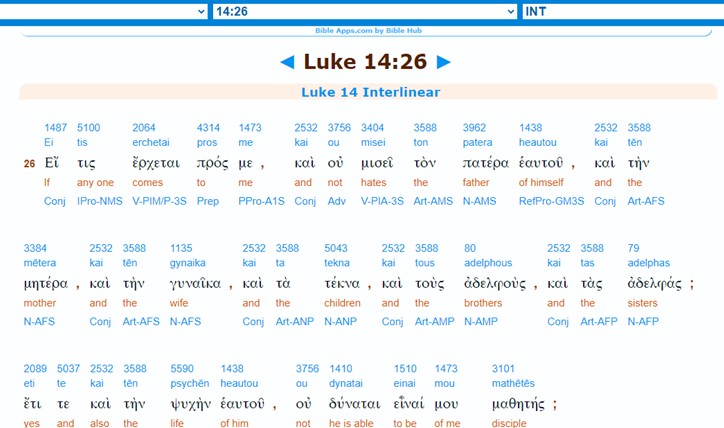Practice on Your Own
This linguistic method of interpretation obviously requires a certain expertise, and not everyone is skilled at learning languages easily. Thankfully you don’t need to learn Hebrew or Greek to practice it. One way is to find a good study bible with detailed comments and footnotes. (See below for examples.) Another option is to read multiple English translations of the same verse. The more variety you see in the translations of a particular verse, the more you will learn about the range of meaning the underlying Hebrew or Greek words have.
Another alternative is to use an interlinear bible, pictured below. This approach will take more work than the others, but it will also produce better results. An interlinear bible means that the Greek or Hebrew text is inserted between the lines of the English translation (thus “inter-linear”). The example pictured below presents the New American Standard translation of Luke 14:26 with the corresponding Greek words listed directly above the English words. If you’re reading this verse and curious why Jesus encourages us to “hate” our family, you can look above the word “hate” and see that it translates the Greek word μισεω. Now here’s where the extra work comes in. You don’t need to learn Greek grammar or syntax or even vocabulary, but if you learn the letters of the Greek alphabet (or better yet, the order of the letters), then you can look up the word μισεω in a Greek-English dictionary. (I recommend the one listed at the bottom of this page, but any dictionary of ancient Greek will do.) It will take a little bit of time to get used to the letters and find the word in the dictionary, but once you do, you’ll discover that μισεω means “hate” but also means “to prefer less,” as when a man has two wives and loves one and “hates” the other – meaning he loves both his wives but prefers one more than the other. Thus, Jesus doesn’t encourage us to “hate” our family in the way we use that word today. Rather, he wants us to prioritize our loves, putting God first and loving everyone else next.

Using an interlinear bible in Hebrew would work similarly, but since the letters, the grammar, and the direction of the writing (right-to-left) are so different, this would be quite a bit more difficult. Still another option for those who don’t have enough time for an interlinear bible is to consult scholarly commentaries on a passage. Commentaries contain the same important information you’d find in the footnotes of a study bible, they’re just more detailed. There are many commentaries out there, but some are more user-friendly than others. A good one-volume commentary for the entire bible is the New Jerome Biblical Commentary or the new Paulist Biblical Commentary. To go even more in depth, you could find a commentary on just one book of the bible. The best ones for laypeople are the volumes in the Sacra Pagina (New Testament) / Berit Olam (Old Testament) series, but there are many other types as well.
Resources
Study Bibles: The Catholic Study Bible or The Anselm Academic Study Bible
Commentaries: for a one-volume commentary, see the New Jerome Biblical Commentary or the Paulist Biblical Commentary. For multi-volume series of commentaries, check out the Berit Olam series and the Sacra Pagina series.
Greek dictionary: A Greek-English Lexicon of the New Testament and Other Early Christian Literature (4th ed.)
Hebrew dictionary: A Concise Hebrew and Aramaic Lexicon of the Old Testament
